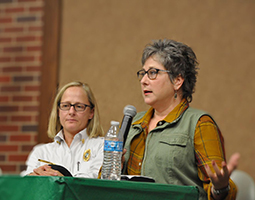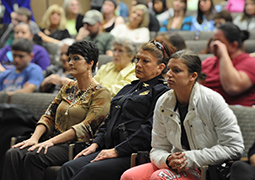
Jan Rader (left) and Necia Freeman respond to audience questions following the Nov. 28 viewing of the Netflix documentary “Heroin(e)” at Ohio University Southern.
IRONTON, Ohio – One hot August day in 2016, Huntington, West Virginia, was thrust into the national and international spotlight. In a four-hour period, 26 individuals overdosed in the city after injecting a powerful mix of heroin and carfentanil, a synthetic opioid more than 10,000 times more potent than morphine. What these stories did not focus on was the fact that none of those 26 overdoses died that day, and for area residents, it was one more story in a series of many that painted the region in a negative light.
Fast forward to Sept. 3, 2017, when “Heroin(e)” was released on Netflix. Elaine McMillion Sheldon, a Logan County, West Virginia native, directed and produced the documentary about three women in Huntington who were making a difference in the battle against the opioid crisis. Judge Patricia Keller, Huntington Fire Chief Jan Rader and Realtor Necia Freeman fight every day to break the cycle one life at a time. “Heroin(e)” didn’t gloss over the opioid crisis in the region, but it focused on one thing all of the other coverage did not – hope.
Ohio University Southern is 20 miles from Huntington, and the Ohio University Proctorville Center is minutes away. The entire campus community has been touched by the crisis in very personal ways.
Because of this, the campus’ Council for Diversity and Inclusion hosted a viewing of “Heroin(e)” followed by a vital discussion with two of the three women featured in the film. More than 180 people packed Bowman Auditorium on Nov. 28 to hear them speak and to ask questions about their work in the community.
In 2011, Freeman started the Brown Bag Ministry for Huntington’s sex workers. Inspired by a Bible verse, the Brown Bag Ministry works to “fill those bags with the love of Christ, friendship and necessary items – and it’s a never-ending supply,” Freeman said. “We presently have about 325 women that we have given brown bags to since 2011 and we’ve probably given out 4,000 or 5,000 bags – there’s just no way to keep an exact count of how many we’ve given out.”
Freeman added, “We go out every week, and start out with a friendship. We follow them on the road that the Lord lays out for us to help these girls— to detox, to rehab or to Jesus.”
Rader, West Virginia’s first female fire chief, said, “Necia is my own personal hero. I’m a fire chief, but that’s my job. Early on, I worked as a nurse in the ER on my days off. I would see Necia serving as the voice of somebody suffering from addiction – begging for help – who had so many problems that they couldn’t be their own patient advocate.”
Freeman often serves in this role, sitting for hours when one of “her girls” is brought to the hospital. As the documentary shows, she also works well into the night finding them housing and basic needs.
Rader is a graduate of Ohio University Southern’s nursing program, and she has appeared in numerous newspapers, magazines and television shows – including “Meet the Press”— to talk about her work in Huntington. She also spends time educating groups in the region about the epidemic.
Despite all of the attention on Huntington, Rader explained that the city isn’t the epicenter of the opioid crisis. “We are just transparent,” she said. “Mayor Steve Williams believes that if you’re transparent about a problem, then you can better work toward solving it.”
Rader also added, “The Netflix documentary was created to show what three women were doing to address the city’s issues. It wasn’t designed to show everything going on in Huntington. There are a lot of people and groups working to help those in need.”
Speaking to school counselors at the Southern Campus the week before, Rader explained, “We need to look at this problem differently. There are no boundaries for this problem – not race, gender or socioeconomic status. I’ve seen nursing colleagues die, I’ve seen lawyers die, I’ve seen physicians die. I’ve seen rich people die, and I’ve seen poor people die. There is one common factor that I see, though: They all have substance use disorder.”
“We have stigmatized them as ‘addicts’ in this country and that’s the wrong thing to do. They already feel bad about what they are going through, and stigmatizing them further makes it worse. We have to realize that our words are powerful,” Rader said.
Keller, who was unable to attend the event, volunteers her time for Drug Court – another program for individuals with substance use disorder that is seeing positive results.
According to Freeman, “In Huntington it costs $7,000 for Drug Court versus $25,000 for prison or jail. Individuals spend one to one-and-a-half years in the program obtaining treatment, job training and therapy. Of the 50 percent who make it through the program, 93 percent never commit another crime. If they go to prison, 93 percent will go back to prison when their term is finished.”
Kristen Berry, a Southern Campus nursing student, attended the event because of Rader.
“I first became interested in her work to combat the opioid epidemic when her merits were discussed at nursing orientation. Jan is battling this crisis on the front line, saving lives and radiating hope to the hopeless,” Berry said. “She has absolutely opened my eyes with regard to providing care to individuals with substance abuse disorder. Healthcare is an environment void of judgment; our duty is to preserve life, without question.”
“I am wholeheartedly invested in this crisis. I have four close family members and friends who have been afflicted by this disease. I lost a parent to the disease of addiction, and have worked since that time to educate myself on charting a new course for others I love,” Berry added. “The commitment of the speakers and the message of hope and responsibility they convey resonate with me. I feel more motivated than ever to be part of the solution.”
Coordinator of Non-Traditional Student Recruitment Mary Ann Wymer, organizer of the event and moderator for the evening, agreed. “We wanted to host this event to show that we have individuals in our communities that are working hard every day to help those in crises,” Wymer said. “This a community problem – and we all have a part to play, even here at the University, as we work to combat it.”

(From left) Ironton Mayor Katrina Keith, Ironton Police Chief Pam Wagner and a community member attend the Nov. 28 viewing of the Netflix documentary “Heroin(e)” at Ohio University Southern.

